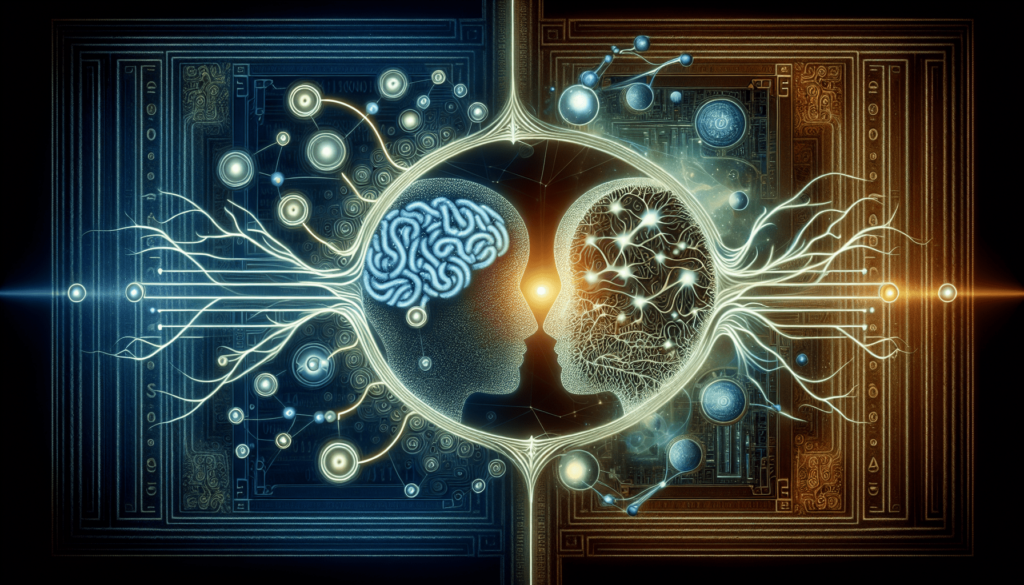So, you’re curious about the relationship between machine learning (ML) and artificial intelligence (AI). Well, let’s dive right in! In this article, we’ll explore the intriguing question of whether ML is a prerequisite for AI. Together, we’ll unravel the intricacies of these two fields and discover how they intertwine to shape the technological advancements of the future. Get ready to embark on a captivating journey through the realm of ML and AI, and uncover the true nature of their connection.

Understanding AI and ML
Artificial Intelligence (AI) and Machine Learning (ML) are two buzzwords that are frequently used in the tech industry. While they are related concepts, it is important to understand their definitions and the relationship between the two.
Definition of AI
AI refers to the development of computer systems that can perform tasks that typically require human intelligence. These tasks may include problem-solving, decision-making, natural language processing, and perception. In simpler terms, AI aims to create machines that can mimic human intelligence and behavior.
Definition of ML
ML, on the other hand, is a subset of AI that focuses on the development of algorithms and techniques that allow computer systems to learn from and improve with experience without being explicitly programmed. ML involves training models on large datasets to identify patterns, make predictions, and generate insights. It is essentially about creating systems that can learn and adapt on their own.
Relationship between AI and ML
While ML is a subset of AI, it is not a prerequisite for AI. AI can exist without ML, but ML can greatly enhance the capabilities of AI systems. ML provides the technology and tools that enable AI systems to learn and improve, making them more intelligent and capable of handling complex tasks.
Different Approaches to AI
There are different ways to approach AI, each with its own strengths and limitations. Let’s explore three main approaches to AI.
Symbolic AI
Symbolic AI, also known as classical or rule-based AI, relies on predefined rules and logic to solve problems. It uses symbols and logical operations to represent knowledge and make inferences. Symbolic AI is based on explicit programming, where the rules are predefined by human experts. While this approach is effective for well-defined problems, it lacks the ability to learn and adapt on its own.
Statistical AI
Statistical AI, also known as machine learning-based AI, uses statistical techniques to analyze and interpret data. It relies on algorithms to identify patterns and make predictions based on past observations. Statistical AI is particularly effective when dealing with large and complex datasets where explicit programming might be impractical. ML plays a crucial role in enabling statistical AI to learn and make accurate predictions.
Connectionist AI
Connectionist AI, also known as neural network-based AI, is inspired by the structure and functioning of the human brain. It involves the use of artificial neural networks, which are interconnected layers of nodes or “neurons” that simulate the process of learning and decision-making. Connectionist AI is highly effective for tasks such as image recognition and natural language processing, where the underlying patterns are complex and not easily defined.
The Role of ML in AI
ML plays a significant role in AI systems, acting as a powerful tool to enhance their capabilities. Let’s explore the role of ML in AI in more detail.
ML as a subset of AI
ML is often considered a subset of AI because it falls under the broader umbrella of creating intelligent systems. ML techniques enable AI systems to learn from experience, make predictions, and generate insights without being explicitly programmed. ML algorithms are designed to automatically adjust their behavior based on the data they are exposed to, making them an integral part of AI systems.
ML’s ability to learn and improve
One of ML’s key strengths is its ability to learn and improve over time. ML algorithms can analyze large datasets, identify patterns, and make predictions based on this learned knowledge. With each iteration, the algorithm becomes more refined and accurate in its predictions. This learning aspect of ML is crucial in creating intelligent AI systems that can adapt to new situations and improve their performance.
Applications of ML in AI systems
ML has numerous applications in AI systems across various industries. For instance, in healthcare, ML algorithms can analyze medical records and predict the likelihood of future diseases or help diagnose conditions. In finance, ML can be used to detect fraudulent transactions or predict stock market trends. In robotics, ML enables machines to learn from their environment and navigate autonomously. These are just a few examples of how ML enhances AI systems and enables them to solve complex problems.
The Evolution of AI and ML
AI and ML have evolved significantly over the years, with new approaches and technologies continually emerging. Let’s take a look at the evolution of AI and ML.
Early AI approaches
Early AI approaches focused on rule-based systems and expert systems, which relied on predefined rules and knowledge provided by human experts. These systems could solve well-defined problems but lacked the ability to learn and improve autonomously. Although they were promising at the time, these approaches had limitations in handling complex and unstructured data.
The rise of ML in AI
ML gained prominence in the field of AI during the last few decades. The availability of large datasets and computational power allowed researchers to develop more sophisticated ML algorithms that could analyze data and learn from it. This shift towards ML opened up new possibilities for AI systems to handle complex problems and adapt to changing environments.
Current trends in AI and ML
Currently, AI and ML are experiencing rapid advancements, driven by advancements in technology and the increasing availability of data. Deep learning, a subset of ML, has gained popularity due to its ability to handle large, unstructured datasets and solve complex problems. Additionally, AI research is focusing on areas such as natural language processing, computer vision, and reinforcement learning. These trends indicate a promising future for AI and ML, with even greater possibilities and applications on the horizon.

AI without ML
While ML has become an integral part of AI, there are instances where AI can exist without ML. Let’s explore a few examples.
Expert systems
Expert systems are AI systems that rely on predefined rules and knowledge provided by human experts. These systems use if-then logic to make decisions and solve problems. While expert systems can be highly accurate and efficient, they lack the ability to learn and adapt on their own. They require constant manual intervention and updates by human experts to remain effective.
Rule-based systems
Rule-based systems are another form of AI that relies on predefined rules and logical reasoning. These systems use a set of rules to make decisions and solve problems. Rule-based systems are effective for narrow and well-defined domains, where the rules can be explicitly defined. However, they struggle with more complex problems and lack the ability to learn and improve based on experience.
Knowledge-based systems
Knowledge-based systems are AI systems that store and manipulate large amounts of knowledge to solve problems. These systems use a knowledge base that contains facts and rules relevant to the problem domain. While knowledge-based systems can be powerful tools, they are still limited by the knowledge they have been provided with. They cannot learn and adapt without human intervention.
Limitations of ML in AI
While ML is a powerful tool for AI systems, it also has its limitations. Let’s explore some of these limitations.
ML’s reliance on large datasets
ML algorithms rely on large datasets to learn and make accurate predictions. Without sufficient data, ML algorithms may not perform optimally or may produce biased results. Collecting and labeling large datasets can be time-consuming and expensive, especially for niche or specialized domains. This reliance on data limits the applicability of ML in certain scenarios.
The black box problem
ML algorithms often operate as “black boxes,” meaning their decision-making process is not transparent or easily interpretable. This lack of transparency raises concerns about bias, discrimination, and the potential for unintended consequences. Understanding and explaining the decision-making process of ML algorithms is an ongoing challenge in AI research and development.
Ethical concerns with ML in AI
ML algorithms can inadvertently perpetuate biases and discriminatory practices if the training data is biased or reflects existing societal inequalities. Additionally, there are ethical concerns regarding privacy, security, and the potential misuse of AI systems. Ensuring that ML algorithms and AI systems are ethical and accountable is a critical challenge that needs to be addressed in the development and deployment of AI technology.
Other Prerequisites for AI
While ML is not a prerequisite for AI, there are other factors that play a crucial role in the success of AI systems. Let’s take a look at some of these prerequisites.
Data quality and preprocessing
High-quality and well-preprocessed data is essential for AI systems to perform optimally. Data needs to be clean, accurate, and representative of the problem domain. Preprocessing techniques, such as data cleaning, transformation, and feature engineering, are used to ensure that the data is in a suitable format for ML algorithms.
Computational power
AI systems often require significant computational power to process large datasets and perform complex calculations. High-performance computing resources, such as GPUs and cloud-based platforms, are necessary to train and deploy AI models at scale.
Domain knowledge
Domain knowledge plays a crucial role in the development of AI systems. Understanding the problem domain, relevant concepts, and the intricacies of real-world scenarios allows AI developers to design effective algorithms and models. Domain knowledge is often combined with ML techniques to create powerful AI systems tailored to specific applications.
Combining ML and Other Approaches in AI
While ML is a powerful approach in AI, combining it with other approaches can further enhance the capabilities of AI systems. Let’s explore how ML can be combined with other approaches.
Hybrid AI systems
Hybrid AI systems integrate different AI approaches, such as symbolic AI, statistical AI, and connectionist AI, to create more robust and adaptable systems. By combining the strengths of different approaches, hybrid AI systems can overcome the limitations of individual approaches and solve complex problems more effectively.
Ensemble methods
Ensemble methods involve combining multiple ML models to make predictions or decisions. By aggregating the outputs of multiple models, ensemble methods can improve accuracy and robustness. Techniques such as bagging, boosting, and stacking are used to create ensembles of ML models.
Advantages and challenges of combining approaches
Combining ML with other AI approaches offers several advantages. It allows for greater flexibility, adaptability, and the ability to handle diverse types of problems. By integrating different approaches, AI systems can leverage the strengths of each approach and mitigate their individual weaknesses.
However, combining approaches also presents challenges. Integrating different approaches requires expertise in multiple AI techniques and may involve complex algorithms and architectures. It also requires careful consideration of how the different components interact and affect the overall performance of the AI system.
The Future of AI and ML
AI and ML are evolving rapidly and have the potential to revolutionize various industries. Let’s explore the future outlook for AI and ML.
Emerging technologies and advancements
Emerging technologies, such as deep learning, natural language processing, and reinforcement learning, are driving advancements in AI and ML. These technologies are enabling AI systems to perform increasingly complex tasks and handle unstructured data more effectively. Additionally, research in areas like explainable AI, federated learning, and ethical AI is advancing the field towards more responsible and transparent AI systems.
Impact on various industries
AI and ML have the potential to transform various industries, ranging from healthcare and finance to manufacturing and transportation. In healthcare, AI can help automate diagnosis, improve patient outcomes, and assist in drug discovery. In finance, AI can automate trading, detect fraud, and personalize customer services. The impact of AI and ML will be far-reaching, with the potential to optimize processes, enhance decision-making, and revolutionize the way we live and work.
Ethical considerations and regulations
As AI and ML continue to advance, it is essential to address ethical considerations and establish regulations to ensure responsible and accountable use of these technologies. Ethical considerations include fairness, transparency, privacy, and safety. Governments and organizations are increasingly recognizing the need for regulations and ethical guidelines to guide the development and deployment of AI systems.
Conclusion
In conclusion, ML is not a prerequisite for AI, but it plays a crucial role in enhancing the capabilities of AI systems. AI encompasses a broader scope of creating intelligent systems, while ML focuses on algorithms that can learn and improve from experience. There are different approaches to AI, including symbolic AI, statistical AI, and connectionist AI, each with its own strengths and limitations.
ML enables AI systems to learn and adapt on their own, making them more intelligent and capable of handling complex tasks. ML’s ability to analyze large datasets, make predictions, and generate insights is critical in various applications of AI. However, there are limitations to ML, such as the reliance on large datasets, the black box problem, and ethical concerns.
Other prerequisites for AI include data quality and preprocessing, computational power, and domain knowledge. Combining ML with other AI approaches, such as hybrid AI systems and ensemble methods, can further enhance the capabilities of AI systems. The future of AI and ML is promising, with emerging technologies, industry impacts, and ethical considerations becoming increasingly important.
As AI technologies continue to advance, it is crucial to address the ethical implications and ensure responsible development and deployment of AI systems. With careful attention to these considerations, AI and ML have the potential to revolutionize various industries and improve the quality of life for individuals worldwide.
